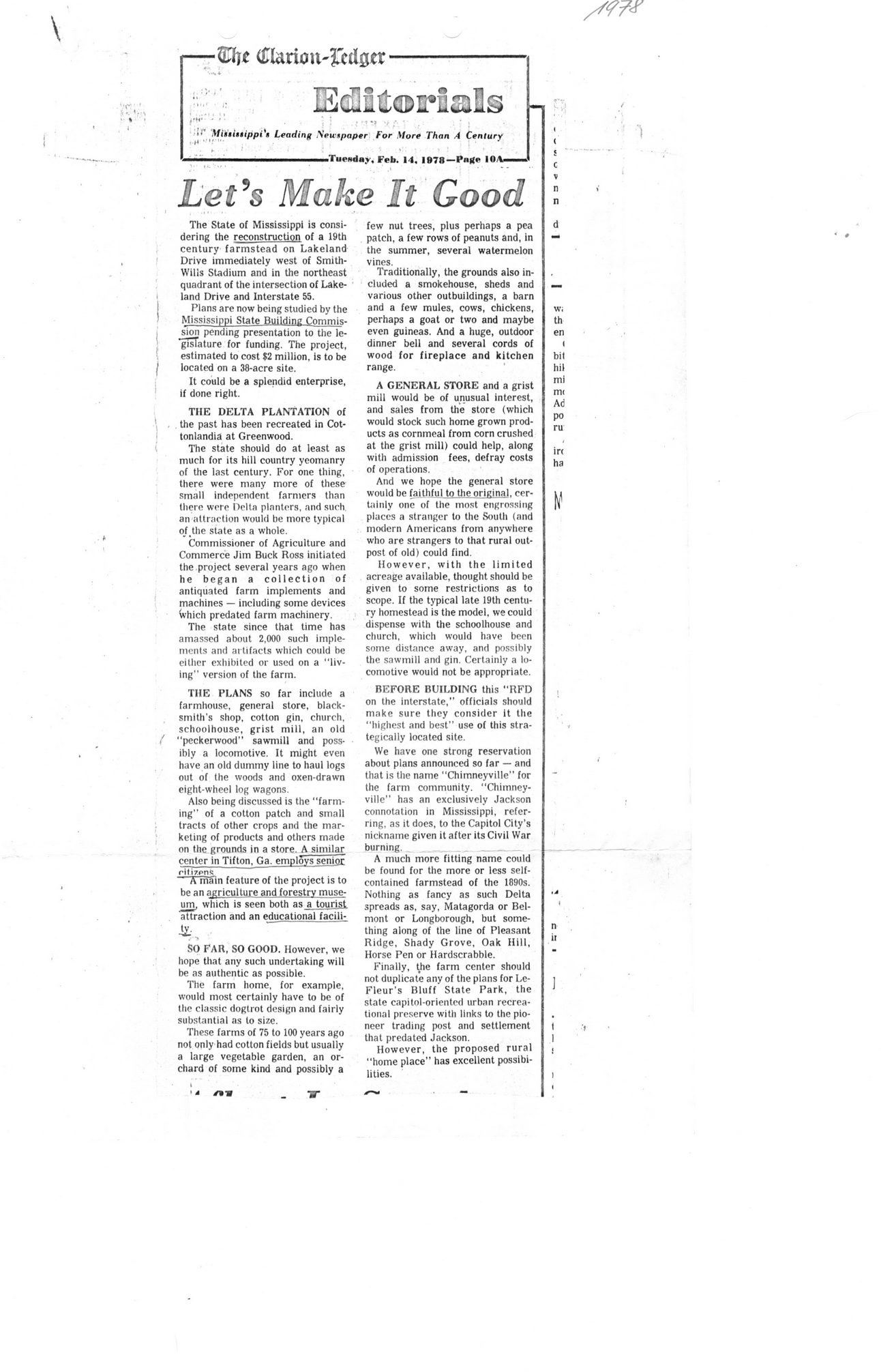This text was obtained via automated optical character recognition.
It has not been edited and may therefore contain several errors.
\ S'??* *?. Vs k % ? i ?fa (flariou-rcdjjtr EMntoiriisiIls ?h* ?il Mi&tittippi's Leading Newspaper For \fore Than A Century f4 -> h s ?,M ?i i Tuesday, Feb. 14, 1878? Page 10/k Let?s Make It Good The State of Mississippi is considering the reconstruction of a 19th century farmstead on Lakeland Drive immediately west of Smith-Wilis Stadium and in the northeast quadrant of the intersection of Lakeland Drive and Interstate 55. Plans are now being studied by the Mississippi State Building Commis-sion pending presentation to the legislature for funding. The project, estimated to cost $2 million, is to be located on a 38-acre site. It could be a splendid enterprise, if done right. THE DELTA PLANTATION of the past has been recreated in Cot-tonlandia at Greenwood. The state should do at least as much for its hill country yeomanry of the last century. For one thing, there were many more of these small independent farmers than there were Delta planters, and such, an attraction would be more typical of.the state as a whole. Commissioner of Agriculture and Commerce Jim Buck Ross initiated the project several years ago when he began a collection of antiquated farm implements and machines ? including some devices Which predated farm machinery. The state since that time has amassed about 2,000 such implements and artifacts which could be either exhibited or used on a ?living? version of the farm. THE PLANS so far include a farmhouse, general store, blacksmith's shop, cotton gin, church, schoolhouse, grist mill, an old ?peckerwood? sawmill and possibly a locomotive. It might even have an old dummy line to haul logs out of the woods and oxen-drawn eight-wheel log wagons. Also being discussed is the ?farming? of a cotton patch and small tracts of other crops and the marketing of products and others made on the grounds in a store. A similar center in Tifton, Ga. employs senior ritizens ' A main feature of the project is to be an agriculture and forestry museum, which is seen both as a tourist attraction and an educational facili- SO TAR, SO GOOD. However, we hope that any such undertaking will be as authentic as possible. The farm home, for example, would most certainly have to be of the classic dogtrot design and fairly substantial as to size. These farms of 75 to 100 years ago not only had cotton fields but usually a large vegetable garden, an orchard of some kind and possibly a few nut trees, plus perhaps a pea patch, a few rows of peanuts and, in the summer, several watermelon vines. Traditionally, the grounds also included a smokehouse, sheds and various other outbuildings, a barn and a few mules, cows, chickens, perhaps a goat or two and maybe even guineas. And a huge, outdoor dinner bell and several cords of wood for fireplace and kitchen range. A GENERAL STORE and a grist mill would be of unusual interest, and sales from the store (which would stock such home grown products as cornmeal from corn crushed at the grist mill) could help, along with admission fees, defray costs of operations. And we hope the general store would be faithful to the original, certainly one of the most engrossing places a stranger to the South (and modern Americans from anywhere who are strangers to that rural outpost of old) could find. However, with the limited acreage available, thought should be given to some restrictions as to scope. If the typical late 19th century homestead is the model, we could dispense with the schoolhouse and church, which would have been some distance away, and possibly the sawmill and gin. Certainly a locomotive would not be appropriate. BEFORE BUILDING this ?RFD on the interstate,? officials should make sure they consider it the ?highest and best? use of this strategically located site. We have one strong reservation about plans announced so far ? and that is the name ?Chimneyville? for the farm community. ?Chimneyville? has an exclusively Jackson connotation in Mississippi, referring, as it does, to the Capitol City?s nickname given it after its Civil War burning. ___________ A much more fitting name could be found for the more or less self-contained farmstead of the 1890s. Nothing as fancy as such Delta spreads as, say, Matagorda or Belmont or Longborough, but something along of the line of Pleasant Ridge, Shady Grove, Oak Hill, Horse Pen or Hardscrabble. Finally, the farm center should not duplicate any of the plans for Le-Fleur?s Bluff State Park, the state capitol-oriented urban recreational preserve with links to the pioneer trading post and settlement that predated Jackson. However, the proposed rural ?home place? has excellent possibilities. Wi th en ( bit hit mi mi Ad po ru i in ha n it /?*

Bartram Editorial-Clarion-Ledger-2-14-78